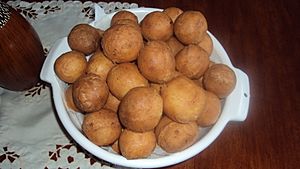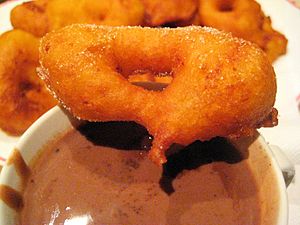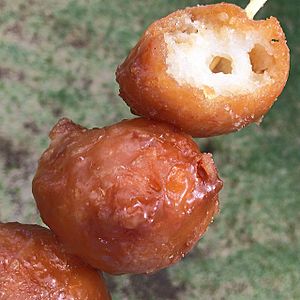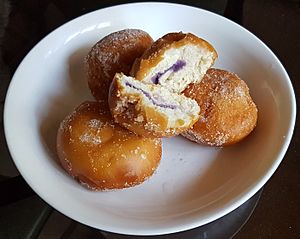Buñuelo facts for kids
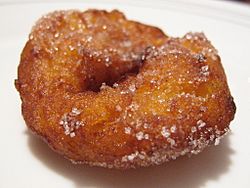
Typical Spanish pumpkin buñuelo
|
|
| Alternative names | Bunyol, bimuelo, birmuelo, bermuelo, burmuelo, bonuelo |
|---|---|
| Type | Doughnut, fritter |
| Course | Snack, bread |
| Place of origin | Spain |
| Region or state | Southwest Europe, Latin America, and parts of Africa and Asia |
| Serving temperature | Hot or room temperature |
A buñuelo (say: boo-NYEH-loh) is a yummy fried dough snack. You might also hear it called bunyol, bimuelo, or bonuelo. It's a type of fritter, which is a small piece of food that's been deep-fried.
Buñuelos are popular in places like Spain, Latin America, and parts of Africa and Asia. People often eat them during special holidays. These include Christmas, Ramadan, and Hanukkah for Sephardic Jewish communities.
Buñuelos usually have a sweet filling or a topping. In Mexico, they are often served with a sweet syrup made from piloncillo, a type of brown sugar.
The first buñuelos were eaten by the Morisco people in Spain. They are usually made from a simple yeast dough with wheat flour. Sometimes, the dough is flavored with anise, a spice that tastes a bit like licorice. The dough is rolled thin, cut into shapes, then fried. After frying, a sweet topping is added. Buñuelos can be round like a ball or flat like a disc. In Latin America, many people believe buñuelos bring good luck!
Contents
History of Buñuelos
Fritters, which are similar to buñuelos, have been around for a very long time. An ancient Roman writer named Cato the Elder wrote about a recipe called "balloons" in his book around 200 BC. This recipe described frying balls of flour and cheese. They were served with honey and poppy seeds.
Later, the Moorish people in southern Spain also enjoyed buñuelos. These were often sold by street vendors. In cities like Seville and Granada, fried buñuelos covered in honey were a popular dessert. Over time, this sweet treat was adopted by other groups, like the gypsies, and it's still enjoyed today.
In the 1800s, a recipe from California for a fried dough was called pasta de freir. It used whipped egg whites mixed with flour, water, sugar, oil, and orange blossom water. This batter was used to fry fruits like apples. Another version, suspiros de monjas (nun's sighs), added butter and egg yolks. Some buñuelos were even topped with walnuts and a sweet syrup flavored with sherry or maraschino.
Buñuelos Around the World
Buñuelos are enjoyed in many different ways across the globe. Each place adds its own special touch!
Buñuelos in Spain
In Spain, buñuelos are a popular dessert and snack, especially during local holidays. Different regions have their own unique recipes. One of the most famous types is the "wind buñuelo," which is a light, airy fritter.
- Catalonia: People in Catalonia often eat buñuelos during Lent. The most popular kinds are wind buñuelos, cream-filled buñuelos, and Brunyols de l'Empordà. They are usually eaten as a snack or with coffee after lunch.
- Valencia: In Valencia, buñuelos are a big hit during festivals like Fallas de Valencia. Here, pumpkin buñuelos are a special treat.
- Balearic Islands: The Balearic Islands have sweet fritters for different holidays. Depending on the occasion, they might contain potato, sweet potato, Mahón cheese, or dried figs.
- Madrid and Andalusia: In Madrid and Andalusia, buñuelos are very popular during the Festival of Saints. In the past, women in villages would make them at home and sell or give them to neighbors.
Sometimes, buñuelos compete with churros in Spain, which are also fried dough snacks. However, in Catalonia, locals often prefer xuixos or their many forms of buñuelos over churros.
Buñuelos in Latin America
Buñuelos are a beloved food throughout Latin America, with each country having its own special version.
- Colombia: In Colombia, buñuelos are made with a small, white cheese. They are shaped into doughy balls and fried until golden brown. They are a traditional Christmas dish, often served with natillas (a custard) and manjar blanco (a sweet milk spread).
- Cuba: Cuban buñuelos are often twisted into a figure-8 shape. They are covered in a sweet anise caramel. The dough for these buñuelos includes cassava and malanga.
- Dominican Republic: In the Dominican Republic, buñuelos are rolled into balls from a dough made of cassava (called yuca) and eggs. They are then covered in a cinnamon sugar syrup, sometimes made with coconut milk.
- Nicaragua: Nicaraguan buñuelos are made from cassava, eggs, and white cheese. They are rolled into balls and deep-fried. They are served with a syrup made of sugar, water, cinnamon sticks, and cloves. They are eaten all year and are a common snack during holidays.
- Mexico: In Mexico, buñuelos are made from a yeast dough with a hint of anise. After deep-frying, they are covered in a syrup made of brown sugar, cinnamon, and guava. Mexican buñuelos are often served with powdered sugar or a cinnamon and sugar topping. They are also popular with hot sugar cane syrup (piloncillo). You can often find them at fairs, carnivals, and Christmas events like Las Posadas.
- Peru: Peruvian buñuelos look similar to picarones (a type of doughnut) because they are round and ring-shaped. However, they don't contain yam or squash like picarones. They are made of flour, water, sugar, anise, and yeast. They are served with a sweet syrup made from chancaca (a sweet derived from sugar cane). They are a common street food in Arequipa.
- Puerto Rico: Puerto Ricon buñuelos are small and round. The dough often contains milk, baking powder, egg, and flour. Many different ingredients can be added, such as apio, cassava, grated corn, potato, sweet potatoes, or plantains. They were well-known in Puerto Rican cooking in the 1800s. They are often filled with cheese and ham for breakfast. Around Christmas, they are popular with syrups made from sugar and spices, honey, or guava.
Buñuelos in Asia
- Philippines: In the Philippines, buñuelos (also called bunwelos) can be shaped like a ball, a pancake, a cylinder, or even a doughnut. They are often eaten with tsokolate, which is a local hot chocolate drink. There are also unique local versions. The most common is cascaron (or bitsu-bitsu), which is made with ground glutinous rice instead of regular flour. Another type is bunwelos na saging, which has mashed bananas mixed into the dough.
Other Adaptations
- Italy: In Italy, buñuelos are usually served with cream. They are very popular during Carnival time, especially in the North-East of the country.
- Uruguay: In Uruguay, sweet buñuelos are made with apples and bananas and covered in sugar. There are also savory (not sweet) versions made from spinach, cow fat, and even seaweed. Seaweed buñuelos are considered a special treat in the Rocha Department.
- Turkey, India, and Russia: You can also find buñuelos in Turkey, India, and Russia. Jewish people in Turkey make buñuelos with matzo meal and eat them during Passover.
In many Latin American countries, this dish can also be made using flour tortillas. These are then covered in sugar or cinnamon.
See also
 In Spanish: Buñuelo para niños
In Spanish: Buñuelo para niños


